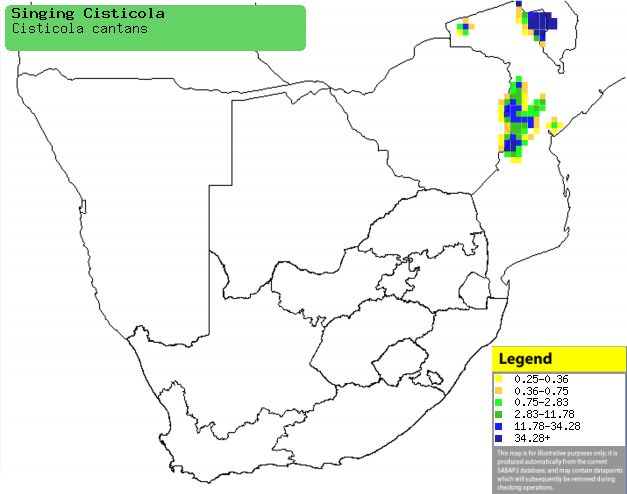|
Cisticola cantans (Singing
cisticola)
Singende tinktinkie [Afrikaans]; Witbrauw-graszanger
[Dutch]; Cisticole chanteuse [French]; Grauer zistensänger [German];
Fuinha-cantora [Portuguese]
Life
> Eukaryotes >
Opisthokonta
> Metazoa (animals) >
Bilateria >
Deuterostomia > Chordata >
Craniata > Vertebrata (vertebrates) > Gnathostomata (jawed
vertebrates) > Teleostomi (teleost fish) > Osteichthyes (bony fish) > Class:
Sarcopterygii (lobe-finned
fish) > Stegocephalia (terrestrial
vertebrates) > Tetrapoda
(four-legged vertebrates) > Reptiliomorpha > Amniota >
Reptilia (reptiles) >
Romeriida > Diapsida > Archosauromorpha > Archosauria >
Dinosauria
(dinosaurs) > Saurischia > Theropoda (bipedal predatory dinosaurs) >
Coelurosauria > Maniraptora > Aves
(birds) >
Order: Passeriformes > Family: Cisticolidae
> Genus: Cisticola
Distribution and habitat
It occurs patchily from West Africa to Uganda through
Tanzania south to southern Africa. Here it locally common in moist riverine
vegetation, especially with scattered trees, bracken (Pteridium) and
brier (Smilax), also occupying edges of riverine forest.
|
 |
|
Distribution of Singing cisticola in southern Africa,
based on statistical smoothing of the records from first SA Bird Atlas
Project (©
Animal Demography unit, University of
Cape Town; smoothing by Birgit Erni and Francesca Little). Colours range
from dark blue (most common) through to yellow (least common). |
Food
It eats a variety of small invertebrates, doing most of its
foraging near the ground in undergrowth. The following food items have been recorded
in its diet:
Breeding
- The nest is an oval or ball shape with a side entrance, built of dry grass
secured with spider web, and lined with soft plant down. It is typically
attached to the leaves of a shrub, herb or bush, usually less then 60
centimetres above ground.
- Egg-laying season is from November-April, peaking from December-January.
- It lays 2-4 eggs, which are incubated solely by the female for about
12-14 days.
- The chicks are fed by both parents, leaving the nest after about 16
days.
Threats
Not threatened.
References
-
Hockey PAR, Dean WRJ and Ryan PG 2005. Roberts
- Birds of southern Africa, VIIth ed. The Trustees of the John Voelcker
Bird Book Fund, Cape Town.
|
